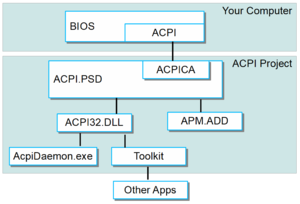ACPI Driver Package: Difference between revisions
Appearance
Created page with "The ACPI project is maintained by David Azawerick and Arca Noae. This quick article is a summary of what David talk about on Warpstock 2016. image:ACPI-Project.png This ..." |
mNo edit summary |
||
| (15 intermediate revisions by 3 users not shown) | |||
| Line 1: | Line 1: | ||
The ACPI project is maintained by David | The ACPI project is maintained by David Azarewicz and Arca Noae. This quick article is a summary of what David discussed at Warpstock 2016. | ||
[[image:ACPI-Project.png]] | [[image:ACPI-Project.png|thumb|ACPI Driver Architecture]] | ||
This is a quick summary of the architecture components of the project: | |||
*'''ACPI''' is located in the BIOS and created by the chipset vendor manufacturer. It is provided with the hardware and it is not modified by any way by the "ACPI Project" and it is not part of this project. | |||
*'''ACPICA''' is the “Component Architecture” which is provided also by Intel. This component is just the same code produced by Intel and does not get modified or debugged in any way, it is used as it is from Intel. The ACPICA code is located into the ACPI.PSD driver. This is updated regularly by Intel and as newer versions are released, the code is merged into the ACPI PSD (Platform Support Driver). | |||
Files: | |||
*'''[[ACPI.PSD]]''' is the Platform Support Driver specific to OS/2. According to David (the developer) this is where the 90% of the effort of the ACPI project is located. In order to stay current, whenever Intel ships new ACPICA code, this driver must to be updated. In this way, when newer hardware is released, written to the new ACPICA specification, the ACPI PSD should be able to recognize and handle it. | |||
*'''[[ACPI32.DLL]]''' is the application interface that allows some services (programs) to query ACPI (temperature monitoring, fan speed, etc.). | |||
*'''[[APM.ADD]]''' is an APM (Advanced Power Management) emulator, which takes the place of [[APM.SYS]] (used on non-ACPI-based systems) to read and control various power functions. | |||
*'''[[ACPIDAEMON.EXE]]''' is a program that talks to the driver thought ACPI32.DLL. It implements functions like CPU throttling, power button actions, lid open/close events, suspend/resume, between others. | |||
The '''ACPI Toolkit''' contains some header files and libraries which allow developers to write applications which access and use ACPI services. Examples of these types of applications include temperature monitoring, screen blanking/saving, system rebooting, etc. | |||
' | ==Links== | ||
* [https://www.youtube.com/watch?v=RAaWSF5mTsk Warpstock 2016 - Day 1 - Session 5 - Arca Noae Device Drivers Recent Progress and Future Plans by David Azarewicz] | |||
* [https://www.arcanoae.com/wiki/acpi/ Arca Noae Wiki - The ACPI Driver Package] | |||
* [http://88watts.net/dlfile.php?F=acpi-toolkit- David's ACPI Toolkit] | |||
* [https://www.acpica.org/downloads The ACPI Component Architecture] (Intel) | |||
[[Category:Driver Articles]] | |||
Latest revision as of 22:56, 21 March 2018
The ACPI project is maintained by David Azarewicz and Arca Noae. This quick article is a summary of what David discussed at Warpstock 2016.

This is a quick summary of the architecture components of the project:
- ACPI is located in the BIOS and created by the chipset vendor manufacturer. It is provided with the hardware and it is not modified by any way by the "ACPI Project" and it is not part of this project.
- ACPICA is the “Component Architecture” which is provided also by Intel. This component is just the same code produced by Intel and does not get modified or debugged in any way, it is used as it is from Intel. The ACPICA code is located into the ACPI.PSD driver. This is updated regularly by Intel and as newer versions are released, the code is merged into the ACPI PSD (Platform Support Driver).
Files:
- ACPI.PSD is the Platform Support Driver specific to OS/2. According to David (the developer) this is where the 90% of the effort of the ACPI project is located. In order to stay current, whenever Intel ships new ACPICA code, this driver must to be updated. In this way, when newer hardware is released, written to the new ACPICA specification, the ACPI PSD should be able to recognize and handle it.
- ACPI32.DLL is the application interface that allows some services (programs) to query ACPI (temperature monitoring, fan speed, etc.).
- APM.ADD is an APM (Advanced Power Management) emulator, which takes the place of APM.SYS (used on non-ACPI-based systems) to read and control various power functions.
- ACPIDAEMON.EXE is a program that talks to the driver thought ACPI32.DLL. It implements functions like CPU throttling, power button actions, lid open/close events, suspend/resume, between others.
The ACPI Toolkit contains some header files and libraries which allow developers to write applications which access and use ACPI services. Examples of these types of applications include temperature monitoring, screen blanking/saving, system rebooting, etc.